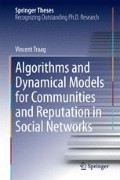Abstract
The distinction between positive and negative links is not often made. Nonetheless, it can be essential for understanding the network structure. We here review an old theory from sociology, known as social balance theory. The idea is similar to the old adage of “the enemy of my enemy is my friend". We will derive some of the classical results, which shows there is a clear connection with the field of community detection.
Access this chapter
Tax calculation will be finalised at checkout
Purchases are for personal use only
References
Bearman PS, Moody J (2004) Suicide and friendships among American adolescents. Am J Public Health 94(1):89–95. doi:10.2105/AJPH.94.1.89
Cartwright D, Harary F (1956) Structural balance: a generalization of Heider’s theory. Psychol Rev 63(5):277–293. doi:10.1037/h0046049
Cartwright D, Harary F (1968) On the coloring of signed graphs. Elem Math 23(4):85–89. doi:10.5169/seals-26032
Cartwright D, Harary F (1979) Balance and clusterability: an overview. Academic Press, New York
Davis JA (1967) Clustering and structural balance in graphs. Hum Relat 20(2):181–187. doi:10.1177/001872676702000206
Easley D, Kleinberg J (2010) Networks, crowds, and markets: reasoning about a highly connected world. Cambridge University Press, Cambridge
Festinger L (1957) A theory of cognitive dissonance. Stanford University Press, Stanford 9780804709118
Friedkin NE (2001) Norm formation in social influence networks. Soc Netw 23(3):167–189. doi:10.1016/S0378-8733(01)00036-3
Greenwald AG, Banaji MR, Rudman LA, Farnham SD, Nosek BA et al (2002) A unified theory of implicit attitudes, stereotypes, self-esteem, and self-concept. Psychol Rev 109(1):3–25. doi:10.1037/0033-295X.109.1.3
Harary F (1953) On the notion of balance of a signed graph. Mich Math J 2(2):143–146. doi:10.1307/mmj/1028989917
Labianca G, Brass DJ (2006) Exploring the social ledger: negative relationships and negative asymmetry in social networks in organizations. Acad Manage Rev 31(3):596–614. doi:10.5465/AMR.2006.21318920
Labianca G, Brass DJ, Gray B (1998) Social networks and perceptions of intergroup conflict: the role of negative relationships and third parties. Acad Manage J 41(1):55–67. doi:10.2307/256897
Lakey B, Tardiff TA, Drew JB (1994) Negative social interactions: assessment and relations to social support, cognition, and psychological distress. J Soc Clin Psychol 13(1):42–62. doi:10.1521/jscp.1994.13.1.42
Maoz Z (2006) Network polarization, network interdependence, and international conflict, 1816–2002. J Peace Res 43(4):391–411. doi:10.1177/0022343306065720
Wasserman S, Faust K (1994) Social network analysis. Cambridge University Press, Cambridge
Wert SR, Salovey P (2004) A social comparison account of gossip. Rev Gen Psychol 8(2):122–137. doi:10.1037/1089-2680.8.2.122
Author information
Authors and Affiliations
Corresponding author
Rights and permissions
Copyright information
© 2014 Springer International Publishing Switzerland
About this chapter
Cite this chapter
Traag, V. (2014). Social Balance. In: Algorithms and Dynamical Models for Communities and Reputation in Social Networks. Springer Theses. Springer, Cham. https://doi.org/10.1007/978-3-319-06391-1_7
Download citation
DOI: https://doi.org/10.1007/978-3-319-06391-1_7
Published:
Publisher Name: Springer, Cham
Print ISBN: 978-3-319-06390-4
Online ISBN: 978-3-319-06391-1
eBook Packages: Physics and AstronomyPhysics and Astronomy (R0)

